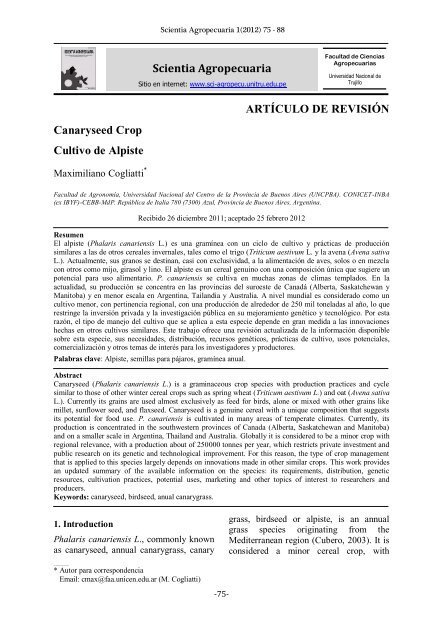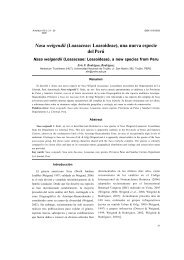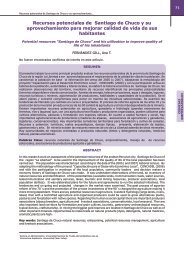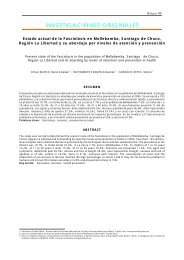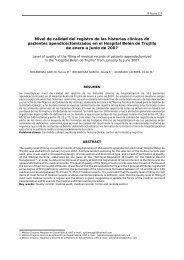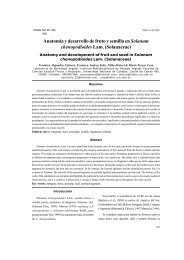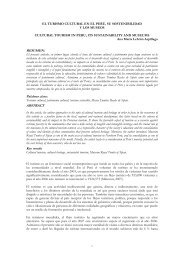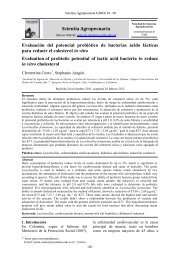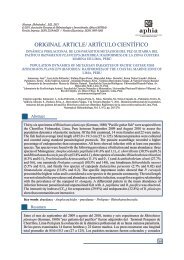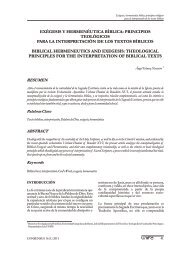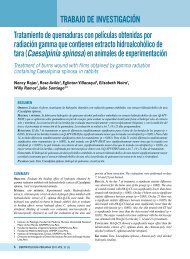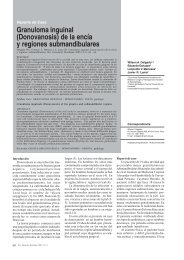ARTÃCULO DE REVISIÃN Canaryseed Crop Cultivo de ... - Dialnet
ARTÃCULO DE REVISIÃN Canaryseed Crop Cultivo de ... - Dialnet
ARTÃCULO DE REVISIÃN Canaryseed Crop Cultivo de ... - Dialnet
- No tags were found...
Create successful ePaper yourself
Turn your PDF publications into a flip-book with our unique Google optimized e-Paper software.
Scientia Agropecuaria 1(2012) 75 - 88Scientia AgropecuariaSitio en internet: www.sci-agropecu.unitru.edu.peFacultad <strong>de</strong> CienciasAgropecuariasUniversidad Nacional <strong>de</strong>TrujilloARTÍCULO <strong>DE</strong> REVISIÓN<strong>Canaryseed</strong> <strong>Crop</strong><strong>Cultivo</strong> <strong>de</strong> AlpisteMaximiliano Cogliatti *Facultad <strong>de</strong> Agronomía, Universidad Nacional <strong>de</strong>l Centro <strong>de</strong> la Provincia <strong>de</strong> Buenos Aires (UNCPBA). CONICET-INBA(ex IBYF)-CEBB-MdP. República <strong>de</strong> Italia 780 (7300) Azul, Provincia <strong>de</strong> Buenos Aires, Argentina.Recibido 26 diciembre 2011; aceptado 25 febrero 2012ResumenEl alpiste (Phalaris canariensis L.) es una gramínea con un ciclo <strong>de</strong> cultivo y prácticas <strong>de</strong> producciónsimilares a las <strong>de</strong> otros cereales invernales, tales como el trigo (Triticum aestivum L. y la avena (Avena sativaL.). Actualmente, sus granos se <strong>de</strong>stinan, casi con exclusividad, a la alimentación <strong>de</strong> aves, solos o en mezclacon otros como mijo, girasol y lino. El alpiste es un cereal genuino con una composición única que sugiere unpotencial para uso alimentario. P. canariensis se cultiva en muchas zonas <strong>de</strong> climas templados. En laactualidad, su producción se concentra en las provincias <strong>de</strong>l suroeste <strong>de</strong> Canadá (Alberta, Saskatchewan yManitoba) y en menor escala en Argentina, Tailandia y Australia. A nivel mundial es consi<strong>de</strong>rado como uncultivo menor, con pertinencia regional, con una producción <strong>de</strong> alre<strong>de</strong>dor <strong>de</strong> 250 mil toneladas al año, lo querestringe la inversión privada y la investigación pública en su mejoramiento genético y tecnológico. Por estarazón, el tipo <strong>de</strong> manejo <strong>de</strong>l cultivo que se aplica a esta especie <strong>de</strong>pen<strong>de</strong> en gran medida a las innovacioneshechas en otros cultivos similares. Este trabajo ofrece una revisión actualizada <strong>de</strong> la información disponiblesobre esta especie, sus necesida<strong>de</strong>s, distribución, recursos genéticos, prácticas <strong>de</strong> cultivo, usos potenciales,comercialización y otros temas <strong>de</strong> interés para los investigadores y productores.Palabras clave: Alpiste, semillas para pájaros, gramínea anual.Abstract<strong>Canaryseed</strong> (Phalaris canariensis L.) is a graminaceous crop species with production practices and cyclesimilar to those of other winter cereal crops such as spring wheat (Triticum aestivum L.) and oat (Avena sativaL.). Currently its grains are used almost exclusively as feed for birds, alone or mixed with other grains likemillet, sunflower seed, and flaxseed. <strong>Canaryseed</strong> is a genuine cereal with a unique composition that suggestsits potential for food use. P. canariensis is cultivated in many areas of temperate climates. Currently, itsproduction is concentrated in the southwestern provinces of Canada (Alberta, Saskatchewan and Manitoba)and on a smaller scale in Argentina, Thailand and Australia. Globally it is consi<strong>de</strong>red to be a minor crop withregional relevance, with a production about of 250000 tonnes per year, which restricts private investment andpublic research on its genetic and technological improvement. For this reason, the type of crop managementthat is applied to this species largely <strong>de</strong>pends on innovations ma<strong>de</strong> in other similar crops. This work provi<strong>de</strong>san updated summary of the available information on the species: its requirements, distribution, geneticresources, cultivation practices, potential uses, marketing and other topics of interest to researchers andproducers.Keywords: canaryseed, birdseed, anual canarygrass.1. IntroductionPhalaris canariensis L., commonly knownas canaryseed, annual canarygrass, canarygrass, birdseed or alpiste, is an annualgrass species originating from theMediterranean region (Cubero, 2003). It isconsi<strong>de</strong>red a minor cereal crop, with_________* Autor para correspon<strong>de</strong>nciaEmail: cmax@faa.unicen.edu.ar (M. Cogliatti)-75-
M. Cogliatti / Scientia Agropecuaria 1(2012) 75 - 88production practices and a life cyclesimilar to other winter grain crops likespring wheat (Triticum aestivum L.)(Robinson 1979a). P. canariensis is theonly species of its genus grown for grainproduction; the others are used mostly asforage crops. The commercial productionof canary seed in Argentina dates from1900s (Bolsa <strong>de</strong> Cereales <strong>de</strong> Buenos Aires,2008 - 2009). In North America commercialproduction started in the 1950s in theUnited States of America, and itscultivation spread to Canada in the 1970s(Li et al., 2010). There is little literatureabout canarygrass crop. The AustralianNew <strong>Crop</strong>s Web Site (2008) found only169 documents that cited Phalariscanariensis between 1926 and 2006.Given the limited knowledge on specificmanagement of this crop, most of thetechnical recommendations have beentransferred from other cereal crops.This work proposes to summarize updatedavailable information on the species, itsrequirements, distribution, genetic resources,cultivation practices, marketing andother topics of interest to researchers andproducers.has small elliptical grains with hullscovered with very fine siliceous hairs ortrichomes. Annual canarygrass seed withan intact hull is shiny and gol<strong>de</strong>n yellow,while <strong>de</strong>hulled canary seed is dark brownin colour (Parodi, 1987) (Figure 1).4. UsesAnnual canarygrass grains are used almostexclusively as feed for birds, alone ormixed with other grains such as millet,sunflower seed, flaxseed and other cerealgrains (Coscia and Castedo, 1967;Miravalles et al., 2002). It is wi<strong>de</strong>lyrecognized as a superior canary feed.Yagüez (2002) mentioned that in smallamounts, canarygrass grains have beenused to produce sizing for cloth ordistillates for alcoholic beverage production.2. TaxonomyCanarygrass belongs to the Poaceae(Gramineae) family, the Pooi<strong>de</strong>aesubfamily and the Agrosti<strong>de</strong>ae tribe. Thisplaces annual canarygrass in the samesubfamily, but different tribe, from wheat,barley (Hor<strong>de</strong>um vulgare L.), and rye(Secale cereale L.) of the Triticale tribe, oroats (Avena sativa L.) of the Aveneae tribe(Putnam et al., 1996).3. DescriptionCanarygrass is an herbaceous plant, ofabout 60–100cm tall, with several tillersand erect growing habit. It has glabrouspods, ligule obtuse 6 to 8mm, flat glabroussheets, 20 to 40mm long by 5 to 10mm andwi<strong>de</strong> compact oval-shaped panicles thatretain the seed firmly. The mature fruitsconsist of a fertile floret and two reducedsterile basal florets. Common canarygrassFigure 1. Illustration of canaryseed plant.References: (A) panicle; (B) spikelet; and (C)hairy hulled grain. Source: USDA-NRCSPLANTS Database.-76-
M. Cogliatti / Scientia Agropecuaria 1(2012) 75 - 88Ford, 2002; Bo<strong>de</strong>ga et al., 2003) and anynecessity for low temperatures is coveredby winter soil temperatures in most of thecases. Length of day affects apicalmorphogenesis, leaf production, tilleringand other <strong>de</strong>velopmental processes incereals (Kirby and Appleyard, 1980).Annual canarygrass is a long day plant,which means that it prefers to flower whenthe daylength is longer, i.e in spring(Norton and Ford, 2002). Regarding itsphotoperiodic requirements, Pascale andGiordano (1962) found that it needs aphotoperiodic threshold slightly over 14hours to start heading.Soil<strong>Canaryseed</strong> will grow successfully in mostsoil types. It has some tolerance to waterlogging, but will basically be suited to anysituation where wheat can be grown(Norton and Ford, 2002). It is moretolerant to salinity and excess of soilmoisture than wheat, and is best adapted toheavy, moisture-retentive soils. Therefore,due to its shallow rooting habits, it doesnot grow well in sandy soils and aridclimates (Putnam et al., 1996). Canarygrasscan grow excessively and may lodgewhen soil fertility and moisture areplentiful. Un<strong>de</strong>r these conditions, a largeamount of vegetative growth, which doesnot necessarily lead to high seedproduction, may be produced (Mc Vicar etal., 2002).7. <strong>Crop</strong> managementSowing<strong>Canaryseed</strong> may be no-till orconventionally sown, using commonseeding equipment, as that used for otherwinter cereals. The optimal sowing timewill <strong>de</strong>pend on the environmentalconditions of each particular site. For agiven site, the different sowing times maylead to different growth temperatures andphotoperiods that affect the duration of the<strong>de</strong>velopmental phase, biomass productionand seed yield (Bo<strong>de</strong>ga et al., 2003). Theoptimum sowing time in North Americancountries - Canada and the United States -is early spring (Putnam et ar., 1996;Miller, 2000), whereas in Argentina andAustralia, the optimum sowing time iswinter (Pascale and Giordano, 1962;Forjan, 1986; Bo<strong>de</strong>ga et al., 2003; Nortonand Ford, 2002). Due to its small seed size,care should be taken to ensure that seedsare placed into a humid firm soil no <strong>de</strong>eperthan 5cm (Mc Vicar et al., 2002).Canarygrass seedlings are relatively weakand cannot force their way up throughcompacted and/or cloddy seedbeds.However, mo<strong>de</strong>rate compaction around theseeds will improve homogeneity an<strong>de</strong>mergence rate (Norton and Ford, 2002). Astudy conducted by Holt (1989) showedthat canarygrass has good adaptability todifferent seeding rates and row spacing.This fact is due to its high capability forcompensation between heads per plant andseeds per head. However, plant <strong>de</strong>nsityand row spacing can modify the crop'sability to compete with weeds. Forjan(1986) and Mc Vicar (2002) both showedthat a <strong>de</strong>nsity of about 550 plants persquare meter is sufficient to obtain highgrain yields and a<strong>de</strong>quate competitivenessagainst weeds. Regarding the row spacing,producers usually use the same as for therest of winter grains (15 to 20cm) to avoidmodifying the configuration of the see<strong>de</strong>rbetween crops.FertilizationThe most efficient fertilizer rate will<strong>de</strong>pend on the residual soil nutrient leveland the yield goal. Excessive use offertilizers, especially nitrogen andphosphorus, has the potential to <strong>de</strong>gra<strong>de</strong>ground and surface water quality.Establishing realistic yield goals, carryingout careful soil sampling in commercialfield plots and fertilizing crops accordingto soil tests will help preserveenvironmental quality (Dahnke et al.,1992). Like other cereal crops, nitrogenand phosphorus are the main limitingnutrients in most of the environments.Lodging is often a problem at highernitrogen levels. Biomass production of-78-
M. Cogliatti / Scientia Agropecuaria 1(2012) 75 - 88canarygrass is below that of other cerealcrops, and so nutrient uptake is likely to besomewhat lower (Putnam et al., 1990). Thebest method of fertilizer application will<strong>de</strong>pend on the source used. In Argentina,canaryseed is often fertilized at sowingwith diammonium phosphate, andbroadcast with urea at tillering. Only a fewstudies on fertilization have been carriedout with canarygrass. In a 5-year study inSaskatchewan, nitrogen fertilizer applied atseeding had no effect on the rate of plant<strong>de</strong>velopment and 1000 grain weight, buthad a positive effect on grain yield andplant height with a linear and quadraticrelationship, where the nitrogen requiredfor maximum yield varied from year toyear over a range of 70 – 120 kg/ha. (Holt1988). In accordance with the above, theSaskatchewan Soil Test Laboratoryrecommends a total of nitrogen (applied +available in soil) of 110kg/ha (cited byHolt, 1988). Table 1 shows the nutrientrequirements recommen<strong>de</strong>d by Dahnke etal. (1992) to achieve different yield goals.Table 1Nutrient recommendations for canarygrass(Adapted from Dahnke et al., 1992).GrainyieldgoalTotalnitrogen a(kg.ha -1 ) (kgN.ha -1 )Soil test phosphorous bVL L M H0-5 6-10 11-15 16-20(kgP 2 O 5 .ha -1 )1682 56 28 17 11 02242 78 34 22 17 02803 101 45 34 17 0a Total nitrogen= Soil N + Applied fertilizer N (in top 60cm of soil).bPhosphorus level (ppm, Bray I): VL= very low; L= low;M= medium and H= high.WeedsWeeds compete with the crop leading toyield losses and sometimes hamper thework of harvesting and cleaning grain.Canarygrass is a poor competitor of weedsin its early stages due to low seedlingvigour and slow growth-rate betweenemergence and tillering (Putnam et al.,1996).Canarygrass is susceptible to the soilresidues of several herbici<strong>de</strong>s liketrifluralin, mazamethebenz, triasulfuron,metsulfuron-methyl, ethametsulfuronmethyl,sulfosulfuron, chlorsulfuron,flucarbazone-sodium and imazethapyr.Exten<strong>de</strong>d periods without rainfall duringthe growing season may extend the recroppingrestrictions on residual products.It is therefore important to record herbici<strong>de</strong>use each year and to avoid plantingcanarygrass in fields with a recent historyof the products listed (Mc Vicar et al.,2008).There are several herbici<strong>de</strong>s capable ofcontrolling annual weed species incanarygrass. A field study conducted inSaskatchewan to evaluate the effect ofherbici<strong>de</strong>s on canarygrass and associatedweeds showed that postemergenceapplication of bromixynil, MCPA orpropanil is a good option to controlbroadleaf weeds without affectingcanarygrass grain and dry matter yield.Also, postemergence application ofdifensoquat and flamprop, or preplantincorporated triallate, optimizes wild oat(Avena fatua L.) control, withconsequently positive effects for grainyield (Holt and Hunter, 1987). There areseveral commercial herbici<strong>de</strong>s available inCanada for the control of broadleaf weeds:BANVEL II (dicamba 48 %) + MCPA(MCPA amine 50 %), BUCTRIL-M(Bromoxynil 28 % + MCPA ester 28 %),PARDNER (Bromoxynil 28 %), andTARGET (MCPA 27.5 % + mecoprop62.5 % + dicamba 62.5 %) and for thecontrol of grassy weeds: ACCORD(quinclorac 75 %), AVA<strong>DE</strong>X G (triallate40 %), AVENGE (Difenzoquat 20 %) andSTAMPE<strong>DE</strong> EDF (Propanil 80%), (McVicar et al. 2002).In other countries such as Argentina andAustralia, the problem of chemical weedcontrol is not yet resolved since they donot have herbici<strong>de</strong>s available for grassyweed control in canarygrass (Norton andFord, 2002; Cogliatti et al., 2011b).-79-
M. Cogliatti / Scientia Agropecuaria 1(2012) 75 - 88than wheat. Mechanisms used by the plantto adjust for stress inclu<strong>de</strong> tiller die-backand blasting of the top portion of the head.If these top florets are not pollinated, theywill die and turn white (Mc Vicar et al.2008). It is believed that floret blasting isalso caused by late frost (Cogliatti et al.,2011b ).InsectsInsects are not a major problem incanarygrass crop. Usually, they are notabundant enough to cause significant yieldlosses. The English grain aphid(Macrosiphum avenae) and the oatbirdcherry aphid (Rhophalosiphum padi)are cited as the main insect pests incanarygrass in Canada. Research has notbeen carried out to <strong>de</strong>termine economicthresholds for aphid infestations in thiscrop. Information from the USA based onother cereal crops, indicates thatapproximately 10 to 20 aphids on 50% ofthe stems and prior to the soft dough stagemay cause enough crop damage to requireinsectici<strong>de</strong> application. It is notrecommen<strong>de</strong>d to spray after the soft doughstage of the seed, because aphids do notcause significant economic damage afterthat time (Putnam et al., 1996; Agri-Fax,1998).Cordo et al. (2004) mentioned otherinsects associated with canarygrass crop inArgentina, like the cereal aphidsMetopolophium dirhodum and Schizaphisgraminum, and the worms Farontaalbilinea, Pseudaletia adultera andSpodoptera frugiperda. Some insectici<strong>de</strong>s,containing malathion or dimethoate, areregistered in Canada for the control ofaphids in canarygrass (Mc Vicar et al.2008).HarvestHarvest time is critical to minimize yieldlosses and produce good quality grains. Ifharvest is too early, the plants will be verydifficult to thresh and will leaveunacceptable green seed. On the otherhand, if harvest is too late, although it willbe easier to thresh and contain fewercontaminants, the seed may be liable tocracking and <strong>de</strong>hulling, and some seedmay be lost from the mature panicles ofmain stems.The problem of uneven maturity isemphasized when crops are sown at lowseeding rates, as the later tillers take muchlonger to mature, with the risk that themain stem can shed much of its seedbefore those tillers are ripe and free ofgreen seed (Norton and Ford, 2002). In thissense, Argentinian producers prefer towindrow prior to crop threshing, tohomogenize maturity and grain drying,when the top half of the panicles areyellow (Forjan, 1986). It is important notto do this when the straw is still greenbecause canaryseed straw is very difficultto cut in these conditions. However, directharvesting is feasible in canarygrass and isoften adopted by producers.Timely and careful harvesting could<strong>de</strong>termine grain quality. Seed merchantsbuy based on visual characteristics such asuniform size, shine and colour (Norton andFord, 2002). The harvesting challenge is tothresh the grains out of the headminimizing <strong>de</strong>-hulling and cracking ofgrains, to maintain sample quality. So, thecombine harvester should be operated atthe minimum cylin<strong>de</strong>r speed for efficientthreshing, and grain flow through thereturn elevator should be adjusted toprevent rethreshing (Putnam et al., 1996).Garrido (1994) measured grain lossesduring the harvest with a prior swath andfound 6.5% of total losses. A yield losstrial conducted in 2002, at the Faculty ofAgronomy in Azul (Argentina), showed a6% loss with this method and 14% losswith a direct harvesting method(unpublished data). However, more workwill be nee<strong>de</strong>d to clarify which of the twomethods results in lower grain losses.8. Processing and storageThe presence of tiny hairs on the hull(palea and lemma) of the seed makescanarygrass dust very irritating to the skinduring harvesting and handling. Thedimensions, composition and structure are-81-
M. Cogliatti / Scientia Agropecuaria 1(2012) 75 - 88similar to those of known carcinogenicmineral fibers and were associated withesophageal cancer (O’Neill et al., 1980).The <strong>Crop</strong> Development Centre (CDC) atthe University of Saskatchewan has<strong>de</strong>veloped canarygrass without these hairs,called the itchless (or glabrous) type.Canadian canarygrass varieties with theglabrous trait have been grouped un<strong>de</strong>r themarketing name Canario (Mc Vicar et al.,2008).Canarygrass is consi<strong>de</strong>red dry at 12percent moisture. In these conditions, itcan be stored safely for a long time withoutquality losses. It is a relatively small seedand will easily flow out through gaps instorage bins or silos. Sealing of joints witha silicone based compound isrecommen<strong>de</strong>d (Norton and Ford, 2002).Special attention is advised in grainmovement to avoid cracking and <strong>de</strong>hulling.Generally, canarygrass does not havemajor problems with grain storage insects.However, canarygrass is preferred byro<strong>de</strong>nts over other seeds and theirdroppings are difficult to separate from thegrains by a common cleaning process(Putnam et al., 1996).Canarygrass should be cleaned before it isshipped for export. It is cleaned toexporters' specifications, usually aminimum purity analysis of 99 per centpure seed with a maximum of 4 per cent<strong>de</strong>hulled seed. Some seed, like Flax andLolium sp., are difficult to separate fromcanarygrass, and buyers will avoidpurchases containing these seeds. Mostcanarygrass is sold to export markets inbulk or in bags (Mc Vicar et al., 2002).9. Genetic resourcesLittle work has been published on thegenetics and breeding of this species.Cultivars have been produced in variouscountries, although little effort has beenspent on genetic improvement in one of themajor producers, Argentina.Annual canarygrass is a self-pollinateddiploid plant (Matus-Cadiz and Hucl2006) (2n = 12) with a genome size of3800 Mbp (Bennett and Smith, 1976).Several authors have found that canaryseedhas little genetic variability in itsmorphology, phenology and itsproductivity (Poverene et al., 1994;Bo<strong>de</strong>ga et al., 1995 and 2003; Putnam etal., 1996; Miravalles et al., 2002; Matus-Cadiz and Hucl, 1999 and 2002) and thismay be the reason why there has been littleprogress in genetic improvement of thisspecies. Nonetheless, Cogliatti et al.(2011a) found potentially useful variationamongst a collection of accessionsobtained from nineteen different countries(<strong>de</strong>tails below). Currently, there are about12 cultivars of annual canarygrass in theworld, among them the threeNorthamerican varieties “Al<strong>de</strong>n”, “Keet”and “Elias”, <strong>de</strong>veloped by Dr. RobertRobinson of the University of Minnesota,in 1973, 1979 and 1983, respectively(Robinson 1979b and 1983); the threecultivars from Hungary “Abad”, “Karcsu”and “Lizard”; the old variety from theNetherlands “Cantate” <strong>de</strong>veloped byJoor<strong>de</strong>ns Za<strong>de</strong>n company in 1985; thecultivar “Judita” from the Czech Republicand the three hairless (glabrous) Canadiancultivars “CDC María”, “CDC Togo” and“CDC Bastia” <strong>de</strong>veloped by Dr. PierreHucl.“CDC Maria” is an annual canarygrassvariety registered in 1997 by the <strong>Crop</strong>Development Center of the University ofSaskatchewan. It has glabrous hulls thatreduce the skin irritation encountered byfarmers during the harvesting process.“CDC Maria” has higher test and kernelweight, but lower grain yield in relation tothe pubescent cultivar “Keet” (Hucl et al.,2001a).A complete quality evaluation wasconducted on the cultivar “CDC Maria”.Phytochemical analysis of canarygrassshowed similarity with wheat in mostcases. Alkaloids and other antinutritionalfactors did not appear to be present insignificant amounts. “CDC Maria”canarygrass flour exhibited dough-formingcharacteristics, permitting blending with-82-
M. Cogliatti / Scientia Agropecuaria 1(2012) 75 - 88wheat. Canarygrass products such as flour,starch, protein, oil and fiber showedpotential for utilization in food and nonfoodproducts. Poultry feeding trialsindicate that glabrous canarygrass canreplace wheat in feed rations. Toxicologyexperiments suggest that <strong>de</strong>hulled glabrouscanarygrass behaves in much the samemanner as common wheat (Hucl et al.,2001b).“CDC Togo” is a glabrous cultivarreleased in 2007. This variety was obtainedat the <strong>Crop</strong> Development Center of theUniversity of Saskatchewan, from thecross of “Cantate” / “CDC Maria” (CanadianFood Inspection Agency. <strong>Crop</strong> ReportCDC-Togo, 2009). “CDC Togo” showed agrain yield increase of about 12% over“CDC Maria”. This means it is nowpossible to grow canarygrass without theirritating itch as well as no yield penalty.Therefore, it is believed that “CDC Togo”could rapidly replace old varieties. “CDCBastia” was released in Canada in 2008and offers higher performance than “CDCMaria” and “CDC Togo” when grown indrought conditions (Hucl, 2009).The glabrous-hulled trait is controlled by asingle recessive gene in annual canarygrass(Matus-Cadiz et al., 2003), meaning thistrait can be transferred easily by crossingto conventional varieties.Although Argentina is one of the threemajor canarygrass producers, it has, asimplied above, no commercial varietiesyet. So, the materials used are populationsthat were kept in each region by thefarmers themselves (Pascale and Giordano,1962). Bo<strong>de</strong>ga et al. (1995) found thatpopulations from different canarygrassgrowing regions did not differ significantlyin grain yield and its components,phenology, biological yield and harvestin<strong>de</strong>x. Therefore, at least from anagronomical point of view, they could beconsi<strong>de</strong>red as belonging to one population(local Argentinian population).As mentioned above, Cogliatti et al.(2011a) evaluated canarygrass accessionsfrom nineteen countries, comprising fiftyinclu<strong>de</strong>d in the United States Departmentof Agriculture (USDA) collection andseven cultivars “Cantate”, “Judita”,“Lizard”, “Abad”, “Karcsu”, “Kisvárdai-41” and “CDC María”. These wereagronomically evaluated in the Province ofBuenos Aires in 2004, 2005 and 2006, anduseful genetic variation was found forgrain yield and its components (grainweight, grain number per square meter,grain number per head and head numberper square meter), harvest in<strong>de</strong>x andphenological characters (emergence toheading, emergence to harvest maturityand heading to harvest maturity). Althoughgenotype x environment interaction wasobserved for all traits, differences observedbetween accessions were sufficient toallow promising breeding materials to bei<strong>de</strong>ntified. Accessions superior in performanceto the local Argentinian population,which in general ren<strong>de</strong>red values close tothe overall mean of the accessionsevaluated, were i<strong>de</strong>ntified.The studies of genetic variability in P.canariensis revealed limited intraspecificdifferences as <strong>de</strong>termined by differentmethodologies: isoezymatic (Matus-Cadiz,1999; Poverene et al., 1994), morphological(Matus-Cadiz, 2002), agronomical(Cogliatti, 2011a; Bo<strong>de</strong>ga et al., 1995,2000, 2003), protein-electrophoretical(Cogliatti, 2009) and molecular (Li et al.,2010). Consequently, it has not beenpossible to <strong>de</strong>velop a methodology for thecomprehensive differentiation of cultivars.10. CompositionStudies on the chemical composition ofcanaryseed grains ma<strong>de</strong> by Robinson(1979a) suggest that it has good nutritionalvalue. Also, the composition of smallgranule starch and gluten-like proteins,rich in tryptophan, suggests uniquefunctional and nutritional properties(Ab<strong>de</strong>l-Aal et al., 1997). In this sense, inrecent years, studies on the composition ofthe grains of birdseed looking for newindustrial and alimentary uses have beenintensified.-83-
M. Cogliatti / Scientia Agropecuaria 1(2012) 75 - 88According to Putnam et al. (1990),canarygrass seed is similar to oat inmineral composition, is higher in ash, oil,and phosphorus, but lower in fiber, thancommonly found in corn, pea, or fieldbean,has higher concentrations of all eightessential amino acids than does wheat orcorn, and is higher in sulfur-containingamino acids than pea or fieldbean. Ab<strong>de</strong>l-Aal et al. (2011a) conclu<strong>de</strong>d thatcanarygrass is a genuine cereal with aunique composition, and used light andfluorescence microscopy to visualisestarch, protein, phenolics and phytate inglabrous canarygrass seed to show that itsmicrostructure is similar to that of othergrasses (wheat, oats, barley, rice), with abran layer surrounding the starchyendosperm and germ. It has higherconcentrations of some minerals andnutrients than wheat. The canaryseedcaryopsis has an average of 55.8 g/100 g ofstarch, 23.7% g/100 g of protein, 7.9% ofcru<strong>de</strong> fat, 7.3 g/100 g of total dietary fibre,1.8 g/100 g of soluble sugar and 2.3 g/100g of total ash in the whole grain. Breadma<strong>de</strong> with up to 25 % of canary seedsshowed similar performance for loafvolume, specific volume and crust colourcompared to that ma<strong>de</strong> from wheat alone(Ab<strong>de</strong>l-Aal et al., 2011a), and canary seedhas been shown to possess a phytochemicaland heavy metal profile similar tothat of wheat (Ab<strong>de</strong>l-Aal et al., 2011b).These findings confirm its potential forfood use.The antioxidant activity of canary grassseeds infusions was <strong>de</strong>monstrated byNovas et al. (2004) by the influence ofthese over the chemiluminescent emissionof a luminol reaction in an oxidizingmedium (hydrogen peroxi<strong>de</strong>). The antioxidantscompounds have potential beneficialeffects in disease prevention and healthpromotion. Among them, carotenoids areconsi<strong>de</strong>red as one group of importantnatural antioxidants. Li et al. (2012)reported that the major carotenoidcompounds i<strong>de</strong>ntified in glabrous canaryseedwere lutein, zeaxanthin and b-carotene, with the latter present in the mostquantities. Phenolics compounds have alsoantioxidant properties and can protectagainst <strong>de</strong>generative diseases. In cerealsgrains these are located mainly in thepericarp. Phenolic acids, flavonoids,con<strong>de</strong>nsed tannins, coumarins, and alkylresorcinollsare phenolics compoundsexamples (Dykes and Rooney, 2007). Li etal. (2011) performed the quantification andi<strong>de</strong>ntification of phenolic constituents inglabrous canaryseed. They found threemajor phenolic acids, ferulic, caffeic andp-coumaric. The LC–MS/MS analysisshowed that acetone extracts of glabrouscanaryseed were rich in flavonoidglycosi<strong>de</strong>s, with the bran being mainlycomposed of O-pentosyl isovitexin and theflour having a compound at m/z 468.Therefor, canaryseeds with high carotenoidand phenolic constituent’s contents couldbe used in functional foods with potentiallyhealth promotion properties.11. Production and marketWorldwi<strong>de</strong>, canarygrass is consi<strong>de</strong>red aminor crop, compared to other grainproducing species. For example, over the<strong>de</strong>ca<strong>de</strong> 2000 - 2009, world canaryseedproduction was 242,621 tonnes per year,compared to 142,930,946 tonnes for barleyand 615,415,472 tonnes for wheat. Worldcanaryseed production hence representsonly 0.17% of that of barley and 0.04% ofthat of wheat (FAO, 2011).Historically, Argentina and Canada havebeen the main producers of canaryseed.Until the end of the 70s Argentina was theworld lea<strong>de</strong>r; later Canada took over andsince then has remained the most importantproducer of this commodity. During thelast <strong>de</strong>ca<strong>de</strong>, Canada, Thailand andArgentina have been the main producers ofcanaryseed. Analysis of canaryseed worldproduction between 1961 and 2008 showsan increasing trend, but with stagnationduring the last <strong>de</strong>ca<strong>de</strong> (Table 2) with aminimum of 46,000 t/year in 1966 and amaximum of 375,000 t/year in 2004 (FAO,2011).-84-
M. Cogliatti / Scientia Agropecuaria 1(2012) 75 - 88Table 2<strong>Canaryseed</strong> world production and country contribution (source: www.fao.org).1961/69 1970/79 1980/89 1990/99 2000/09Country t % t % t % t % t %Argentina 319600 51.9 449700 47.1 463500 32.9 306321 12.8 153846 6.3Australia 71098 11.5 106778 11.2 87363 6.2 52071 2.2 50649 2.1Canada 0 0.0 0 0.0 653900 46.5 1720400 71.6 1848900 76.2Czech Republic 0 0.0 0 0.0 0 0.0 0 0.0 3677 0.2Hungary 0 0.0 0 0.0 0 0.0 255217 10.6 98836 4.1Mexico 46005 7.5 119349 12.5 95067 6.8 18564 0.8 3376 0.1Morocco 42200 6.8 166410 17.4 48540 3.4 3200 0.1 0 0.0Netherlands 11707 1.9 400 0.0 0 0.0 0 0.0 0 0.0Spain 17653 2.9 64266 6.7 21238 1.5 2524 0.1 575 0.0Thailand 3600 0.6 9200 1.0 16400 1.2 21200 0.9 233522 9.6Turkey 80100 13.0 25690 2.7 5531 0.4 3051 0.1 2355 0.1Uruguay 24294 3.9 12096 1.3 15600 1.1 19700 0.8 30475 1.3Total 616257 953889 1407139 2402248 2426211Figure 2 shows the evolution of the priceof canaryseed grains received byproducers, in American dollars per tonnefor the main countries between 1991 and2008, which highlights a clear disparitybetween countries and the lack of a uniqueinternational price.Figure 2. Evolution of the price of canaryseedgrains.On the other hand, Argentinian producershave profited in respect to the rest; and it isevi<strong>de</strong>nt that although prices obtained inThailand were higher than those ofAustralia, there is a certain similarity intheir behaviour for both countries.Argentinian canaryseed is consi<strong>de</strong>red aspeculation crop. This is due to the highvolatility experienced by grain prices andthe facility with which producers adopt thiscrop since it requires neither equipmentnor technologies different to those used intraditional crops (Coscia and Castedo,1967).12. ConclusionsThe main constraint for the expansion ofbirdseed crops is the lack of alternativeuses, resulting in a rigid and limitedmarket. Future research should be directedto the discovery of new potential uses. Inthis sense, the <strong>de</strong>velopment of glabrouscultivars has expan<strong>de</strong>d the possibilities ofusing the canarygrass grains for humanconsumption. Beyond the geneticimprovements already ma<strong>de</strong> in canarygrass,there are still some pending issues,such as: the <strong>de</strong>velopment of dwarf or semidwarfvarieties to minimize plant lodgingproblems, the finding of sources ofresistance to diseases and herbici<strong>de</strong>s, andthe obtention of varieties with greaterproductive potential. Breeding techniquesnot hitherto applied in the crop mayfacilitate progress in these and otheraspects; for example, Li et al. (2010)<strong>de</strong>veloped microsatellite markers in or<strong>de</strong>r-85-
M. Cogliatti / Scientia Agropecuaria 1(2012) 75 - 88to characterize the biodiversity present inthe crop, opening up possibilities formarker-assisted selection in the future.Most canaryseed management practiceshave been adapted from other major cropssuch as wheat and barley. Therefore,improvement in crop productivity isexpected by means of the adjustment ofagronomical practices and the <strong>de</strong>velopmentof new specific technologies.The availability of commercialization toolsfor canaryseed such as the future marketsand sowing contracts could favour theseeding of this crop since it wouldminimize risks and provi<strong>de</strong> greaterforesight to the business.AcknowledgmentsI wish to thank Dr. W. John Rogers andProf. Sylvia Benson for their assistance inthe preparation of this work.ReferencesAb<strong>de</strong>l-Aal, ESM.; Hucl, P.; Sosulski, F. W. 1997.Characteristics of canaryseed (Phalaris canariensis L.)starch. Starch 49: 475-80.Ab<strong>de</strong>l-Aal, ESM.; Hucl, P.; Miller, S. S.; Patterson, C. A.;Gray, D. 2011a. Microstructure and nutrientcomposition of hairless canary seed and its potential asa blending flour for food use. Food Chemistry 125:410-416.Ab<strong>de</strong>l-Aal, ESM.; Hucl, P.; Patterson, C. A.; Gray, D.2011b. Phytochemicals and heavy metals content ofhairless canary seed: A variety <strong>de</strong>veloped for food use.LWT - Food Science and Technology 44: 904-910.Albuquerque, U. P.; Me<strong>de</strong>iros, P. M.; Almeida, A. L. S.;Monteiro, J. M.; Neto, E. M. F. L.; Melo, J. G. L.2007. Medicinal plants of the caatinga (semi-arid)vegetation of NE Brazil: a quantitative approach. JEthnopharmacol 114: 325-354Australian New <strong>Crop</strong>s Web Site, Listing of InterestingPlants of the World, Phalaris canariensis. 2008.Disponible en http://www.newcrops.uq.edu.au/listing/species_pages_P/Phalaris_canariensis.htmBennett, M. D.; Smith, J. B. 1976. Nuclear DNA amountsin angiosperms. Phil Trans R Soc Lond B. 274: 227-274.Berkenkamp, B.; Jesperson, G. D.; Bissett, J. 1989. Leafmottle, a new disease of canarygrass caused bySeptoria triseti Speg. Plant Disease 73: 859.Bo<strong>de</strong>ga, J. L.; De Dios, M. A.; Rodríguez, R. H.; PereyraIraola, M. 1995. Caracterización agronómica <strong>de</strong>poblaciones comerciales <strong>de</strong> alpiste. Revista Facultad<strong>de</strong> Agronomía 15 (2-3): 161-170.Bo<strong>de</strong>ga J. L.; De Dios, M. A.; Pereyra Iraola, M. 2000.Comparative yield of native and introduced canarygrass (Phalaris canariensis ) cultivars sown at twosowing date. Test of Agrochemicals and Cultivars, Nº21. Edited by R Bryson & MA Froment. Associationof Applied Biologists.Bo<strong>de</strong>ga J. L.; De Dios, M. A.; Pereyra Iraola, M. 2002.Variación en las etapas fenológicas <strong>de</strong> alpiste enrespuesta a la fecha <strong>de</strong> siembra en Balcarce. RevistaFacultad <strong>de</strong> Agronomía 22 (1): 1-2.Bo<strong>de</strong>ga J. L.; De Dios, M. A.; Pereyra Iraola, M. 2003.Análisis comparativo <strong>de</strong>l rendimiento en semillas yotras características <strong>de</strong> interés agronómico enpoblaciones locales y cultivares introducidos <strong>de</strong>alpiste. Revista Facultad <strong>de</strong> Agronomía 23 (2-3): 147-154.Bolsa <strong>de</strong> Cereales <strong>de</strong> Buenos Aires - Números Estadísticos.2008 – 2009. 107-111.Braun, U. 1995. Amonograph of Cercosporella, Ramulariaand allied genera (Phytopathogenic hyphomicetes). 1:333.Canadian Food Inspection Agency - <strong>Crop</strong> Report 2009.CDC-Togo. Disponible en: Cogliatti, M. 2009. Variabilidad genética en alpiste comobase para su mejoramiento. Trabajo <strong>de</strong> tesis <strong>de</strong>Magister Scientiae. Facultad <strong>de</strong> Ciencias Agrarias.Universidad Nacional <strong>de</strong> Mar <strong>de</strong>l Plata. Bs. As.Argentina.Cogliatti, M.; Bongiorno, F.; Dalla Valle, H.; Rogers, W. J.2011a. <strong>Canaryseed</strong> (Phalaris canariensis L.)accessions from nineteen countries show usefulgenetic variation for agronomic traits. Journal of PlantScience. 91: 1-12.Cogliatti, M.; Bongiorno, F.; Dalla Valle, H.; Rogers, W. J.2011b. Control of grassy weeds in annual canarygrass.<strong>Crop</strong> Protection 30: 125 -129.Cordo, H. A.; Logarzo, G.; Braun, K.; Di Iorio, O. R. 2004.Catálogo <strong>de</strong> insectos fitófagos <strong>de</strong> la Argentina y susplantas asociadas. South American Biological ControlLaboratory. Sociedad Entomológica Argentina,Buenos Aires, Argentina. 734 p. ISBN 987-21319-1-0Coscia, A. A.; Castedo, A. V. 1967. El Alpiste, grano <strong>de</strong>especulación. Informe técnico Nº 70. EstaciónExperimental Agropecuaria Pergamino - InstitutoNacional <strong>de</strong> Tecnología Agropecuaria (INTA)Argentina.Cubero, J.I. 2003. Introducción a la Mejora GenéticaVegetal, Eds Mundi-Prensa Spain, Cap. 1 pp 3-22.Dahnke, W. C.; Fanning, C.; Cattanach, A. 1992.Fertilizing Millet and Canary Seed. North Dakota StateUniversity. Disponible en: http://www.ag.ndsu.edu/pubs/plantsci/soilfert/sf726w.htm.Delhey, R.R.; Kiehr, M.; Zappacosta, D. 2004. Escaldaduray otras enfermeda<strong>de</strong>s <strong>de</strong> alpiste en la región pampeanaargentina. IV Simposio Nacional <strong>de</strong> <strong>Cultivo</strong>s <strong>de</strong>Siembra Otoño-Invernal, Bahía Blanca. Buenos Aires.Libro <strong>de</strong> Actas: 345.-86-
M. Cogliatti / Scientia Agropecuaria 1(2012) 75 - 88FAO, 2011. Food and Agriculture Organization of theUnited Nations (access date: 04/08/2011).Dykes, L.; Rooney, L. W. 2007. Phenolic Compounds inCereal Grains and Their Health Benefits. Cereal FoodsWorld 52(3):105-111.Fischer, R. G.; Dall`Agnol, M. 1987. Introduction an<strong>de</strong>valuation of annual winter grasses. Herbage Abstracts057 00851.Forjan, H.J. 1986. Alpiste: situación <strong>de</strong>l cultivo y sumanejo. Instituto Nacional <strong>de</strong> TecnologíaAgropecuaria (INTA) Chacra Experimental Barrow.Hoja <strong>de</strong> divulgación N° 54.Garrido, R.H. 1994. Determinación <strong>de</strong> las pérdidas en elproceso <strong>de</strong> hilerado y recolección <strong>de</strong> un cultivo <strong>de</strong>alpiste (Phalaris canariensis L) Tesis, Facultad <strong>de</strong>Ciencias Agrarias, Universidad Nacional <strong>de</strong> Mar <strong>de</strong>lPlata.Gui<strong>de</strong> to <strong>Crop</strong> Protection 2011. Saskatchewan Ministry ofAgriculture, Canada.Holt, N.W.; Hunter, J.H. 1987. Annual CanarygrassPhalaris Canariensis Tolerance and Weed ControlFollowing Herbici<strong>de</strong> Application. Weed Science 35:673-677.Holt, N.W. 1988. Effect of nitrogen fertilizer on theagronomic performance and seed quality of annualcanarygrass. Canadian Journal Plant Science. 68: 4l-45.Holt, N.W. 1989. Effects of Row Spacing and SeedingRate on the Agronomic Performance of AnnualCanarygrass. Canadian Journal of Plant Science 69:1193-8.Hucl, P.; Matus-Cadiz, M.; Van<strong>de</strong>nberg, A.; Sosulski, F.W.; Ab<strong>de</strong>l-Aal, E. S. M.; Hughes, G. R.; Slinkard, A.E. 2001a. CDC Maria annual canarygrass. CanadianJournal Plant Science 81: 115–116.Hucl, P.; Han, H. L.; Ab<strong>de</strong>l-Aal, E. S. M.; Hughes, l. G. R.2001b. Development and quality of glabrouscanaryseed. AFIF Project # 96000287. Disponible en:http://www.agriculture.gov.sk.ca/19960287.pdfHucl, P. 2009. <strong>Canaryseed</strong> breeding & research Update2009. Disponible en: http://www.cropweek.com/presentations/2009/2009-jan12-canaryseed-hucl.pdf>Juan, V. F.; Monterroso, L.; Cogliatti, M,; Dalla Valle, H.;Bongiorno, F.; Rogers, W.J. 2004. Control <strong>de</strong>escaldadura causada por Rhynchosporium secalis encultivo <strong>de</strong> alpiste. VI Congreso Nacional <strong>de</strong> Trigo. IVSimposio Nacional <strong>de</strong> <strong>Cultivo</strong>s <strong>de</strong> Siembra Otoño-Invernal, Bahía Blanca. Buenos Aires. Libro <strong>de</strong> Actas:361-362.Kirby, K. J. M.; Appleyard, M. 1980. Effects ofphotoperiod on the relation between <strong>de</strong>velopment andyield per plant of a range of spring barley varieties. Z.Pflanzenzuchtg 85: 226–239.Li, W.; Beta, T. 2012. An evaluation of carotenoid levelsand composition of glabrous canaryseed. FoodChemistry 133:782–786.Li, W.; Qiu, Y.; Patterson C. A.; Beta, T. 2011. Theanalysis of phenolic constituents in glabrouscanaryseed groats. Food Chemistry 127:10–20.-87-Li, J.; Båga, M.; Hucl, P.; Chibbar, R. N. 2010.Development of microsatellite markers in canary seed(Phalaris canariensis L.). Molecular Breeding DOI:10.1007/s11032-010-9513-2.Matus-Cadiz, M.; Hucl, P. 1999. Isoenzyme variationwithin and among accessions of annual Phalarisspecies in North America Germoplasm Collections.<strong>Crop</strong> Science 39: 1222-1228.Matus-Cadiz, M.; Hucl, P. 2002. Morphological variationwithin and among five annual Phalaris species.Canadian Journal Plant Science 82: 85-88.Matus-Cadiz, M.; Hucl, P.; Van<strong>de</strong>nberg, A. 2003.Inheritance of hull pubescence and seed color inannual canarygrass. Canadian Journal of Plant Science83:(3) 471-474.Matus-Cadiz, M.; Hucl, P. 2006. Outcrossing in annualcanarygrass. Canadian Journal Plant Science 46: 243-246.Mc Vicar, R. S.; Hartley, C.; Brenzil, P.; Panchuk, K.;Hucl, P.; May, B. 2002. <strong>Canaryseed</strong> in Saskatchewan.Farm Facts, Saskatchewan Agriculture and Food.ISSN 0840-9447 0057.Mc Vicar, R. S.; Hartley, C.; Brenzil, P.; Panchuk, K.;Hucl, P.; May, B. 2008. <strong>Crop</strong> Overview: <strong>Canaryseed</strong>Government of Saskatchewan. Disponible en:http://www.agriculture.gov.sk.ca/Default.aspx?DN=b3b1fd99-df9c-4da2-bd0e-342b<strong>de</strong>f9e69Miller, P.R. 2000. Effect of varying seeding date on crop<strong>de</strong>velopment, yield, and yield components incanarygrass. Canadian Journal of Plant Science 80: 83-86.Miravalles, M. T.; Gallez, L. M.; Möckel, F. E. 2002.Alpiste: Revisión <strong>de</strong> la situación <strong>de</strong>l cultivo.Agronomy Journal 22 (1): 7-17.Monterroso, L.; Juan, V. F.; Cogliatti, M.; Rogers, W. J.2004. Escaldadura en alpiste, nueva enfermedad<strong>de</strong>tectada en la zona Centro <strong>de</strong> la Provincia <strong>de</strong> BuenosAires. VI Congreso Nacional <strong>de</strong> Trigo. IV SimposioNacional <strong>de</strong> <strong>Cultivo</strong>s <strong>de</strong> Siembra Otoño-Invernal,Bahía Blanca. Buenos Aires. Libro <strong>de</strong> Actas: 367-368.Norton, R. M.; Ford, J. F. 2002. Canarygrass: Industry<strong>de</strong>velopment for south-eastern Australian. A report for<strong>de</strong> Rural Industries Research and DevelopmentCorporation. RIRDC Publication Nº 01/178, ProyectNº UM-42A. 91p.O’Neill, C. H.; Hodges, G. M.; Riddle, P. N.; Jordan, P.W.; Newman, R. H.; Flood, R. J.; Toulson, E. C. 1980.A fine fibrous silica contaminant of flour in the highoesophageal cancer area of north-east Iran.International Journal of Cancer 26: 617-628.Parodi, L. R. 1987. Enciclopedia Argentina <strong>de</strong> Agriculturay Jardinería, ACME S.A.C.I. Buenos Aires, Tomo I:137-138.Pascal, A. J.; Giordano H. J. 1962. Característicasbioclimáticas que <strong>de</strong>terminan la época <strong>de</strong> siembra <strong>de</strong>lalpiste. Revista Facultad <strong>de</strong> Agronomía y Veterinaria,T. XV (2): 30-52.Pelikan, J. 2000. Evaluation of yield in canary grass(Phalaris canariensis L.) varieties. Rostlinná Výroba46 (10): 471-475.
M. Cogliatti / Scientia Agropecuaria 1(2012) 75 - 88Pedraza, M.; Pérez, B. A. 2010. Enfermeda<strong>de</strong>s <strong>de</strong> Phalariscanariensis L. (alpiste). Atlas Fitopatológico Argentino(Eds. Nome SF, Docampo DM, Conci LR, Pérez BA.Córdoba, Argentina. Disponible en: http://www.fitopatoatlas.org.ar/<strong>de</strong>fault.asp?hospedante=1038Poverene, A. M.; Carrera, D.; Marincioni, M. C.; Bo<strong>de</strong>ga,J. L. 1994. Variación isoenzimática en una colección<strong>de</strong> alpiste. III Congreso Nacional <strong>de</strong> Trigo y ISimposio Nacional <strong>de</strong> Cereales <strong>de</strong> Siembra Otoño-Invernal, Bahía Blanca. Libro <strong>de</strong> actas pp 279-280.Putnam, D. H.; Oelke, E. A.; Oplinger, E. S.; Doll, J. D.;Peters, J. B. 1990. Annual Canarygrass. AlternativeField <strong>Crop</strong>s Manual, University of Wisconsin,University of Minnesota. Disponible en:http://www.hort.purdue.edu/newcrop/afcm/cangrass.htmlPutnam, D. H.; Miller, P. R.; Hucl, P. 1996. Potential forproduction and utilization of annual canarygrass.Cereal Food World 41: 75-83.Ribeiro, R. <strong>de</strong> A; Fiuza <strong>de</strong> Melo M. M.; De Barros F.;Gomes C.; Trolin, G. 1986. Acute antihypertensiveeffect in conscious rats produced by some medicinalplants used in the state of São Paulo. Journal ofEthnopharmacology 15: pp. 261-269.Robinson, R. G. 1979a. Chemical composition andpotential uses of annual canarygrass. AgronomyJournal 70: 797-800.Robinson, R. G. 1979b. Registration of “Keet” annualcanarygrass. <strong>Crop</strong> Science 19: 562.Robinson, R. G. 1983. Registration of “Elias” annualcanarygrass. <strong>Crop</strong> Science 23: 1011.Thacker, P. A. 2003. Performance and carcasscharacteristics of growing-finishing pigs fed dietscontaining gra<strong>de</strong>d levels of canaryseed. CanadianJournal of Animal Science 83: 89-93.USDA, NRCS. (2012). The PLANTS Database. NationalPlant Data Team, Greensboro, NC 27401-4901 USA..Disponible en: http://plants.usda.govWright, C. I.; Van-Buren, L.; Kroner, C. I.; Koning, M. M.G. 2007. Herbal medicines as diuretics: a review of thescientific evi<strong>de</strong>nce. Journal of Ethnopharmacology114: 1-31.Yaguez, J. L. 2002. Alpiste: un cultivo olvidado. ConvenioINTA - Ministerio <strong>de</strong> Asuntos Agrarios <strong>de</strong> la provincia<strong>de</strong> Buenos Aires. Disponible en:http://www.inta.gov.ar/barrow/info/documentos/agricultura/alpiste/alpiste.pdf.-88-


